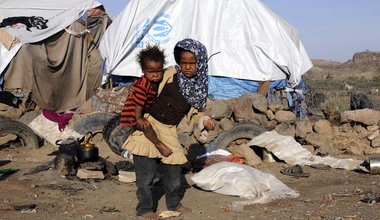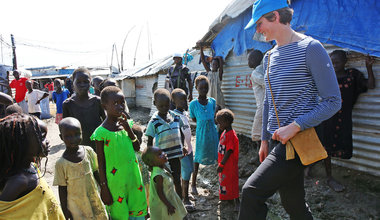Search and rescue missions in Sahara Desert help 1,000 migrants, says UN migration agency
 Search and rescue operations conducted by the United Nations migration agency have saved a total of 1,000 migrants in northern Niger since April, the agency reveals.
Search and rescue operations conducted by the United Nations migration agency have saved a total of 1,000 migrants in northern Niger since April, the agency reveals.
“I was shocked when, not far from the border between Niger and Libya in Toummo, we came across a large group of women mainly from Nigeria and Ghana sleeping in a dark hangar quite close to the border post, waiting for their next passage north,” said Alberto Preato, Programme Manager of the Migrant Resource and Response Mechanism (MRRM) at the International Organization of Migration (IOM) in Niger on one mission.
From 19 to 25 July, IOM conducted an assessment mission of migratory routes in the Ténéré desert and the area surrounding Niger's border with Libya. The aim of the mission was to improve migrant rescues, by understanding better how to assist migrants in distress on that route and strengthen the Government's management migration capacity.
With Niger's Department of Civil Protection, IOM covered more than 1,400 kilometres in the country's north – identifying challenges and changes in flows and migratory routes, while also rescuing more than 150 migrants in distress.
The search and rescue operations are an integral part of the Migrants Rescue and Assistance in Agadez Region project, funded by the Netherlands – and which is complementary to the larger Migrant Resource and Response Mechanism (MRRM) initiative, developed by IOM Niger and financed by the European Union.
Since January, IOM pointed out that more than 60,000 individuals have been observed entering Niger, while, at the two flow monitoring points in Séguedine and Arlit, only half that number was counted as leaving. Compared to the previous year, much fewer migrants have been reported both coming in and going out.
Following its latest assessment mission and seeing that smugglers are using more dangerous routes, IOM is looking at implementing new flow monitoring points in the country.
“We need to better understand how trafficking and smuggling networks intersect, and to further increase our presence in these remote areas in order to provide information, assistance and alternatives to migrants in need,” Mr. Preato said.
During one of the latest search and rescue missions, conducted in cooperation with the Nigerien Civil Protection, IOM staff rescued 23 Gambian and Senegalese migrants, including a 7-year-old girl, who had been abandoned by their drivers.
On the mission, staff encountered some migrants they had previously met in ghettos around Agadez. Despite being informed about the dangers and risks of irregular migration, these migrants had decided to try their luck and headed for Libya.
“I feel that I have failed them in some way, but I am happy to see they are alive,” said one IOM community mobilizer.
Calling his rescue “a miracle,” one of the survivors said, “I should have listened to them; I should have never embarked on this route.”
The rescued migrants are now recovering at IOM's transit centre in Agadez as they wait for assistance to voluntarily return to their countries of origin.
 UN
UN







